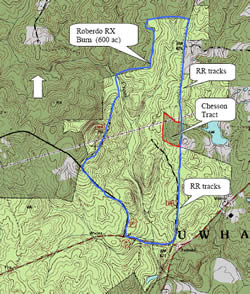
National Fire Plan Success Story
CWPP Prescribed Burn
Uwharrie National Forest
2007

Roberdo Prescribed Burn map.
The Uwharrie National Forest was able to accomplish a hazardous fuels burn on a tract that contained private land that historically had been excluded from burning. This private land was approximately 30 acres (see map), and contained a stand of young (5 to 7 years old) longleaf pines. The Forest Service had routinely conducted prescribed fires on three sides of the private property, and typically had to plow fire lines around these sides. The landowner was approached about burning on his property, and he was interested in doing so. This private property (Chesson Tract) is included in a Community Wildfire Protection Plan (CWPP) for the town of Troy, NC. In accordance with direction in the CWPP, a hazardous fuel reduction burn was accomplished, and the 30-acres of private property was included.
Incorporating this private land in the prescribed fire met several objectives. It accomplished goals relating to the Troy CWPP. It also allowed the Forest Service to use a long section of railroad tracks, rather than having to plow around this property, which saved the district both time and money. Including the tract in the burn unit made conducting the prescribed fire much easier logistically as well. It also allowed fire to be applied into the longleaf ecosystem, which is a Forest Plan objective on the Uwharrie. The fire burned well, and reduced hazardous fuels on both Forest Service property and on private property that is within the wildland urban interface.
Contact: Kelly Cagle, District Fire Management Officer; phone: (910) 576-6391 or email: kcagle@fs.fed.us.